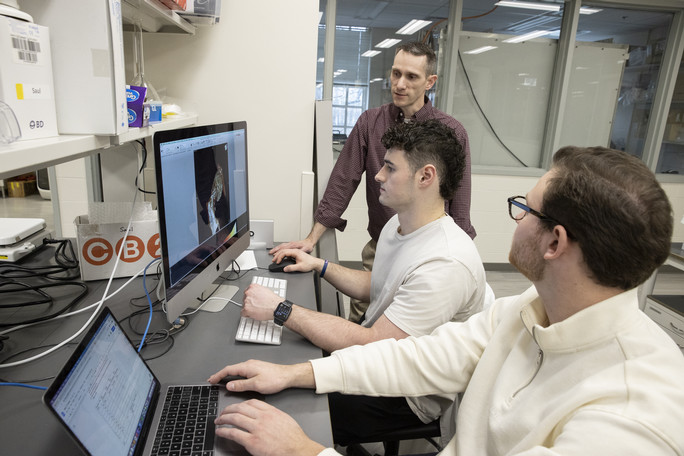Dr. Justin Saul receives research grant from National Institute of Arthritis and Musculoskeletal and Skin Diseases
Miami University CEC professor Justin Saul recently received a multi-year grant of $2.5 million funding research on potential treatments for osteoporosis in females from the National Institutes of Health, specifically the National Institute of Arthritis and Musculoskeletal and Skin Diseases.
Dr. Justin Saul receives research grant from National Institute of Arthritis and Musculoskeletal and Skin Diseases
By Gabby Benedict, CEC Student Intern
Justin Saul, a professor at Miami University's College of Engineering and Computing, recently received a multi-year grant of $2.5 million to help fund research on potential treatments for osteoporosis. The grant is funded by the National Institutes of Health (NIH), specifically the National Institute of Arthritis and Musculoskeletal and Skin Diseases (NIAMS).
The project, entitled “Sustained Regulation of Hypothalamus-Pituitary-Ovary Hormones with Tissue-Engineered Ovarian Constructs as a Treatment for Osteoporosis in Females," focuses on the hypothesis that utilizing a cell-based therapy will potentially improve the regulation of hormones in females as a treatment for osteoporosis associated with the loss of ovarian function.
The project also involves Michael O'Connell and Byran Smucker in the Department of Statistics and Andor Kiss, Director of the Center for Bioinformatics and Functional Genomics at Miami. The project will be conducted as a collaboration between Miami University, Wake Forest University Health Sciences, Wake Forest University, and Virginia Commonwealth University.
This research can potentially provide a simple alternative solution to drug-based forms of hormone therapy that frequently require remembering to take pills, creams, or patches to deliver hormones. The cell-based construct would help release other hormones naturally secreted by native ovaries in the body but that are not found in traditional hormone therapies. This could lead to a safer, more long-term implant for preventing and treating osteoporosis in females.
“An easy way to explain is, if you take a drug that has progesterone and estrogen in it, those are two major players. But there are multiple other hormones that a woman's ovaries secrete such as activin, inhibin, progesterone, and even testosterone. With a drug, you're getting two big pieces of the pie, but you're not getting everything, so the goal of this research is to have the cell-based construct act as an artificial ovary and secrete more hormones than a pill typically could,” Saul said.

This grant will fund the cost of materials involved with harvesting cells, fabricating and testing the cell hormone therapy constructs, and hiring research personnel to aid in completing the research project. The long-term goal of the research is to develop a cell-based therapy that can be used in humans to prevent osteoporosis associated with loss of ovarian function in females.
Saul has worked with multiple Miami students on this research, including recent alumnus Rachel Duke and senior Nick Stanich, who recently published a paper alongside Saul on a mathematical model demonstrating the potential for cell-based hormone therapy.
Saul has been a professor at the CEC’s Chemical, Paper, and Biomedical Engineering department for 12 years and has a research background in the use of biomaterials for various drug delivery systems including chemotherapy agents, gene therapy, protein delivery, and cell therapy.